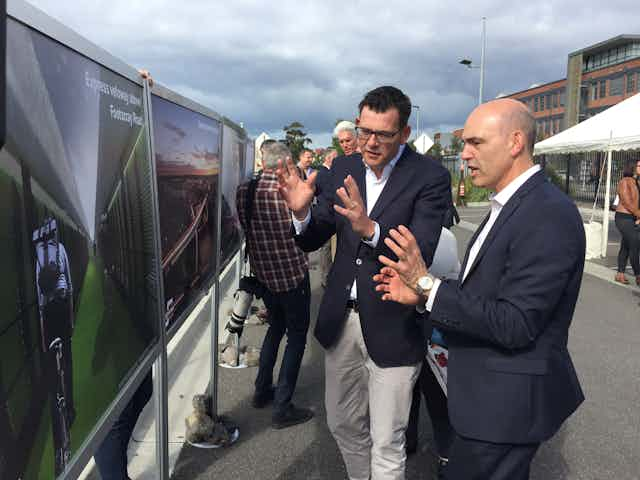Last week Victorians awoke to their very own Groundhog Day, with the Victorian government signing a contract to build the controversial A$6.7 billion West Gate Tunnel Project.
Like the controversial East West Link, this project has no electoral mandate, and was rushed through the formal planning processes. It’s also part of a trend seen in other Australian states for projects to be announced before alternative planning options are considered.
Read more: East-West Link shows miserable failure of planning process
The project will affect 13km of Melbourne’s inner west. It will have 3km of twin tunnels, 5km of double-decked 6-lane roads and many added freeway lanes, culminating in city-bound off-ramps.
Contracts have been signed for this project, for which toll-road monopolist Transurban will put up A$4 billion of the capital cost.
Using new provisions for “market-led” infrastructure proposals, the project has avoided public scrutiny. It was an “unsolicited project” presented by Transurban to the government, meaning there was no tender, and in our opinion Transurban has become the de-facto transport planning agency.
Deja vu?
After the 2014 state election, the new Victorian government fulfilled its controversial election promise to cancel the East West Link (EWL).
We supported cancellation because of improper process and lack of evidence-based planning, believing it would create a city Melburnians do not want to live in. Many of these views were supported by findings of the Victorian Auditor General.
Three years on, the Victorian government has expedited contract closure for an equally bad road project. The West Gate Tunnel is 12 times larger than the A$500 million West Gate Distributor promised by the Australian Labor Party in 2014. The government hasn’t clearly established the need for the larger project.
Expert opposition
Just before contracts were signed, 28 Victorian urban planning, transport, health, safety and engineering experts expressed deep concerns to state parliamentarians. They called for an integrated transport plan for Melbourne and Victoria, as required under the Transport Integration Act (2010).
Their open letter accompanied a report outlining serious problems with the West Gate Tunnel project, summed up in two key concerns.
First, transport planning for Melbourne lacks an evidence base, rigour, transparency and independent peer review. Decisions to undertake projects often precede their justification.
Second, recent decisions to proceed with major road projects have not considered viable alternatives, as required by the Act. Public transport, active travel, or behaviour change alternatives that would make better use of existing assets have not been tested. This is not unique to Victoria: New South Wales and Western Australia have similarly proposed controversial toll road projects without considering alternatives.
Parliament should put the West Gate Tollway on hold to allow democratic review, while preparing an integrated Victorian transport plan. The academic community and the many community sector advocacy groups stand ready to assist in this process.
Look to other cities
The Victorian government’s recent decisions to pursue the North East Link and West Gate Tunnel are a regrettable retreat from at least two decades of metropolitan and state planning strategies based on strong in-principle commitments to public transport over private car-based solutions.
This retreat begs the vital question at the heart of the planning process: what kind of city-region do we want to be?
Cities around the world have responded to that same question in different ways. Many have made a long-term commitment to expanding public transport to enable car-free cities. Soon, central London will have a car-free area equivalent to a third of Melbourne’s CBD. In some cases, cities have decommissioned inner-city motorways. Few cities continue to build motorways that bring car-based traffic into the inner city; Melbourne appears to be one exception.
Read more: Impending traffic chaos? Beware the problematic West Gate Tunnel forecasts
We believe the West Gate Tunnel will be unable to meet its objectives, its benefits have been overstated, and on top of the state’s inadequate transport planning, the market-led process to fund it has been opaque.
Parliament should limit its support for strategic road investment in Melbourne’s inner west to the A$500 million West Gate Distributor. This project was proposed to remove trucks from residential streets as part of the 2014 ALP election platform. This is one election promise Melbourne cannot afford to have broken.
Not a done deal
Transport projects are never fully immune from electoral politics. This is particularly the case for projects where planning is called into question.
Eleven months out from the next state election, the West Gate Tunnel project still has to pass a number of hurdles. One is the legislation to allow a 10-year extension of CityLink tolls. The government has said the state will cover Transurban’s A$4 billion stake if the toll extension is rejected, but the project is a bad one, however it is funded.
The project must also pass another hurdle: the planning scheme amendment GC65 facilitating the West Gate Tunnel which can be revoked by either house of the Victorian Parliament. This process was recently used to stop a 13-storey tower planned above a suburban Melbourne train station.
However, as has been reported, Transurban thinks it does not require planning approval from the state government. If this is true, then what was the Environmental Effects Assessment process and the preparation of Amendment GC65 all about?
Allowing a private corporation to adopt the roles of a state planning agency, infrastructure provider and toll collector without the need for parliamentary approval puts us in uncharted and dangerous territory.

